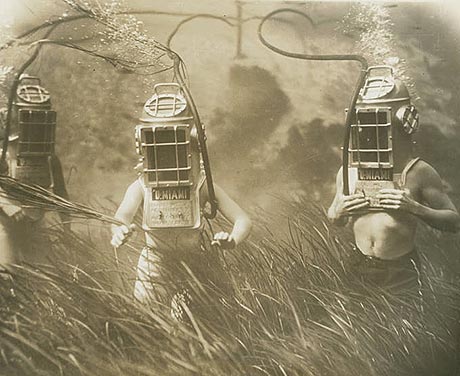The first record of scientific diving at the University of Miami dates back to the mid 1920’s when zoology classes started using diving helmets to study the underwater environments around Soldier Key, about 15 miles southeast of Miami. The account of these diving practices was published in July 1928 in the American Association for the Advancement of Science in an article titled “Diving Experiment at the University of Miami.”
The next record of scientific diving at the University of Miami was in the early 1940’s. Students ventured into the water wearing surface supplied hard helmets with their “buddies” operating a hand pump which supplied the air. Divers were limited to capabilities of the technology.
The invention of the “Aqua Lung” or Self Contained Underwater Breathing Apparatus (SCUBA) by Cousteau and Gagnan gave divers another mode of discovering the underwater environment. Divers including UM scientists and students, were allowed to leave the restrictive land based support equipment behind and explore the oceans, rivers, lakes, and streams.

The mid 60’s had the University of Miami forming a scientific diving program under the supervision of Bob Johnson. Johnson’s duties were to make sure divers were trained and qualified for the tasks they were to perform.
The 1970’s saw the Rosenstiel School Scientific Diving Program become a formal scientific diving program. Under the direction of Tom Mount (now President of International Association of Nitrox and Technical Divers (IANTD)), the SDP developed a training curriculum, policies and procedures and standards. The UM SDP supported divers in disciplines such as bioacoustics and oceanography. Under Mount the SDP introduced mixed gas diving to Rosenstiel School scientists. Tom Mount left the University in 1976.
Stu McCormick followed Mount as the Dive Officer for the Rosenstiel School. The program under McCormick maintained a steady course helping scientists conduct research underwater.
In 1983 Jack Nichols took the reins and formalized the SDP, forming a program which is the foundation of the present day Scientific Diving Program at the University of Miami.

In 1987 the Rosenstiel School SDP became an Organizational Member of the American Academy of Underwater Sciences (AAUS). AAUS is the nationally recognized scientific diving entity and has developed the national, consensual standard for scientific diving in the U.S.
The Rosenstiel School Scientific Diving Program membership meant the SDP had to adopt the AAUS standards. These include standards for diver training and qualifications as well as diving practices. Fortunately there was not much to change, but these new standards allowed Rosenstiel School divers to travel and conduct diving operations with other organizations with out having to go through the host organizations qualification/training procedures.
In 1994 Rick Riera-Gomez became the Diving Safety Officer for the Rosenstiel School. Rick grew the program from there until the fall of 2011 when Robbie Christian was brought on as the Assistant Diving Safety Officer. In 2020, Rick retired after a successful career of 26 years and Robbie departed the Rosenstiel School to pursue a new career in Instructional Design.
In early 2021, Jason Nunn became the first Senior, Diving Safety Officer after serving as DSO for over 8 years at East Carolina University. Jessica Keller was hired as the Diving Safety Officer after serving 9 years in federal service.

Today, the program has over 130 active science divers logging between 3,000 to 4,000 dives annually in a variety of different dive modes (open circuit, hookah, surface supply, closed-circuit rebreather, staged decompression, double tanks, diver propulsion vehicles, etc) in a variety of environments (reef, seagrass, blue water, drift, cavern, cave, boat, shore, fresh water, salt water, night, wall, etc).






